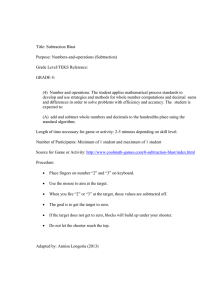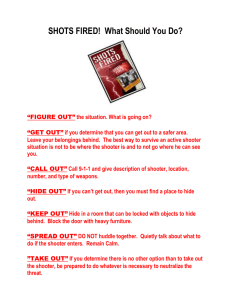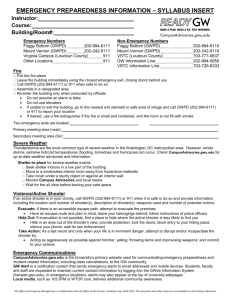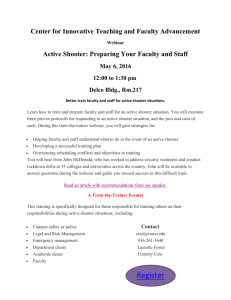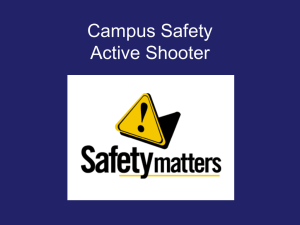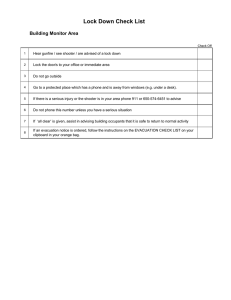Department of Public Safety See Something, Say Something
advertisement
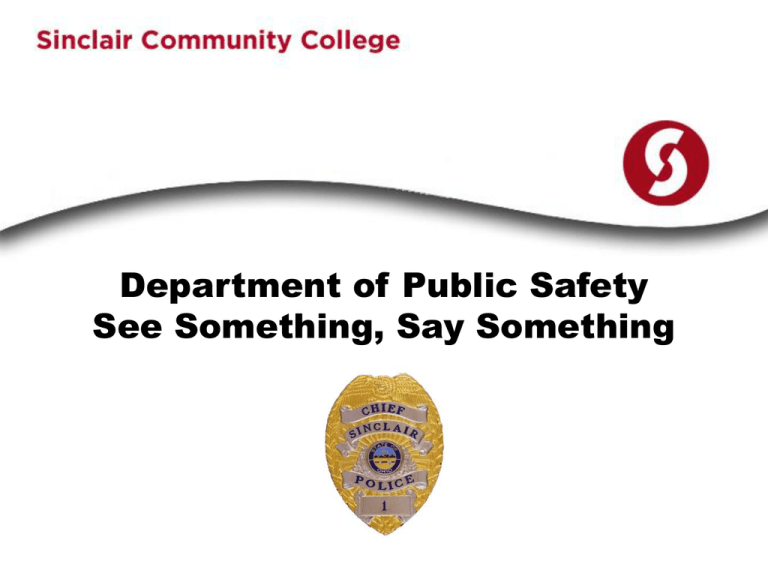
Department of Public Safety See Something, Say Something Subject Training The Department of Public Safety and Sinclair Police take pride in maintaining a safe campus for staff, faculty, students and visitors. This PowerPoint© presentation is part of the department’s on-going program to provide informative training that the campus community may study and learn from. Sinclair Police officers that patrol the campus are available to answer any questions. In addition, the Sinclair Police Speaker’s Bureau can provide an officer to speak to any campus group by contacting the department at (937) 512-2700. Active Shooter Options This presentation is also available on video • Sinclair Community College prides itself on maintaining safe campuses whether you are taking classes at the Dayton Campus, Courseview Campus or any of the learning centers located in Montgomery and Preble counties. • But bad things can occur anywhere despite the precautions taken. • One of the most publicized incidents involves an active shooter. • What are your options if you encounter an active shooter? Active Shooter Options An active shooter is actively engaged in the killing or the attempted killing of people. In most cases, active shooters use firearms as their weapon of choice, while displaying no predetermined selection of their victims. Active shooter incidents are fluid-like, ever-changing and place tremendous demands upon law enforcement as they deploy personnel in an effort to quell the shooter’s intentions to kill innocent people. Hopefully, this presentation will provide you with more insight into what is involved in a shooter scenario and what to expect from responding law enforcement officials. Active Shooter Options • How you respond to an active shooter situation will depend upon several dynamic and personal limitations. • Always keep in mind that there may be more than one shooter involved as well as multiple buildings. • Although it may be difficult, always try to remain calm and project that calmness to anyone else that may be with you. • Pay attention to all instructions which you may hear from law enforcement from a myriad of avenues. Active Shooter Options The active shooter is highly publicized but we also may encounter workplace violence incidents as well. • The “typical” active shooter may have several of these characteristics; • A student with a vendetta, a disgruntled employee or estranged significant other, usually middle-aged Caucasian man • Has poor social skills and is likely to be very familiar with firearms • There is most likely a recent personnel office action against the person • May be a misfit, loner, nonconformist, eccentric, oddity, rebel • Has difficulty coping with losses and/or failures or has a history of being bullied or teased Active Shooter Options • The active shooter has the desire to kill or seriously injure without concern for his/her safety or the threat of capture. • The shooter will continue to move throughout an area until stopped by law enforcement, he/she commits suicide, or there is some other intervention. • Sinclair’s challenges include Not having a centralized administrative office Unrestricted visitor access at all campuses Classrooms are generally unlocked during business hours • The advantages Sinclair has is a rapid law enforcement response from a dedicated and concerned campus community Solidly constructed facilities that provide places of refuge and multiple escape routes Active Shooter Options What can you do to protect yourself from an active shooter? There are four options to consider: Get Out Call Out Hide Out Take Out Active Shooter Options: Get Out • Leave the area and run in the opposite direction • Leave your belongings behind • Get yourself and others out of the immediate area and go to a safe place • Put as much distance between yourself and the shooter as possible • Once you have reached a safe area, Call Out Active Shooter Options: Call Out • • • • • Don’t assume that someone else has contacted the police Contact police by calling 911. Provide your specific location and stay on the phone with the dispatcher Number of people at your location Number of people injured (if any) and the type of injuries Active Shooter Options: Call Out • Give the specific location of the assailant(s) and how many there are - Race and gender - Clothing description - Physical features- height, weight, facial hair, glasses - Type and number of weapon(s). (e.g. rifle, shotgun, handgun, etc.) - Backpack, bags, containers? - Do you recognize the assailant? If so, who is he/she? - Have you heard explosions separate from gunshots? • If you are unable to get out of the immediate area where the shooter is, then your option is to Hide Out. Active Shooter Options: Hide Out • Hide in an area out of the active shooter’s view and secure the immediate area • Stay calm – your actions will influence others • Assure others that the police are working to protect them • Lock your classroom or office door. A toggle lock is located on most doors • Block the door using whatever is available: furniture, chairs, etc. • Stay out of sight from any interior or exterior windows. • Close blinds • Turn off radios and computer monitors Active Shooter Options: Hide Out • Silence cell phones (without turning them off, if possible) • Keep occupants calm and quiet • Position occupants out of sight, on the floor and behind items that might offer additional protection – walls, file cabinets, etc. • Attempts to rescue persons should only be made if the rescue can be done without further endangering the persons inside a secure area. • Consider the risk of exposure created by opening the door. • If there is any doubt about compromising the safety of persons in the secured area, the area must remain secured. Active Shooter Options: Hide Out • Remember that the shooter may bang on a door and yell for help to entice you to open the door. • Know all alternate exits in your building • Remember the safety of the masses versus the safety of a few • Remember the shooter will not stop until his objectives have been met or are engaged by an outside force • Remember that the safest place for you is inside a secure area • Hide out if the shooter has NOT detected you and be prepared to confront and Take Out the shooter. Active Shooter Options: Take Out • ONLY as a last resort and only when your life is in imminent danger should you make an attempt to take down the shooter. • If you take a shooter down, do not hold on to the weapon. • When police enter the scene, they will not know if you are the shooter. Keep the weapon close to you but put a box or trash can over it. • A group can take a shooter down easily. There is no more risk of the loss of life because the shooter intends to kill anyway. Active Shooter Options: Take Out • Technique 1 - shooter enters and students throw anything at him and tackle him • Technique 2 - upon hearing gunshots, a couple students get near door and create diversion • Technique 3 - same as #2 except lights are turned out and obstacle placed within couple feet of door with students ready to tackle and escape out of room • The only wrong action is no action!! • Keep the survival mindset that you will survive!! Never give up, you will survive!! Active Shooter: After It’s Over What happens when it is all over? • Remain in secure areas until instructed otherwise • When the police arrive, put down any item you may have in your hands and keep them visible at all times • You may be instructed to keep your hands on your head • Avoid making any quick movements toward officers such as holding on to them for safety • Avoid pointing, screaming or yelling Active Shooter: After It’s Over • • • • • • You may be searched You will be escorted out of the building by law enforcement personnel Do not stop to ask officers for help or directions when evacuating Once evacuated, no one will be permitted to re-enter the crime scene. You will likely be interviewed about the incident by police officers Medical care and post incident counseling services will be made available as soon as practical, as well as in the days, weeks, and months following. If You See Something…. Say Something • Safety is a shared responsibility of all members of the Sinclair community. • Please help us keep our community safe by being aware of possible threats, by quickly reporting observations and by taking a leadership role during emergencies. IF YOU SEE SOMETHING, SAY SOMETHING. Contact Sinclair Police Dispatch at 937.512.2700 or 9-1-1 from any campus phone
